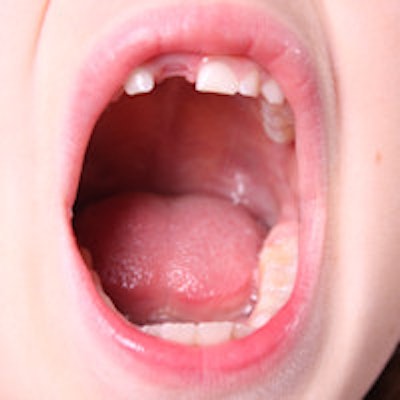
Does providing postoperative local anesthetic in addition to intravenous analgesics improve comfort in children undergoing dental surgery under general anesthesia? Research presented on March 24 at the 2018 American Association of Dental Research (AADR) meeting in Fort Lauderdale, FL, took a look.
Investigators administered one of two established pain management options to children who underwent dental treatment under general anesthesia:
- Intravenous analgesics with gingival local anesthetic interpapillary infiltrations (experimental group)
- Intravenous analgesics only (control group)
Preliminary data based on 20 of the study's 60 participants indicated that postoperative pain was mild and was similar between the groups.
"I was most surprised by the low overall postoperative level of pain," Kelly Lipp, DDS, the study's lead author and a pediatric dental resident at Ohio State University/Nationwide Children's Hospital in Columbus, told DrBicuspid.com in an email interview.
It's not so bad
Pediatric dental pain is underreported and can be difficult to assess, with postoperative pain management being suboptimal, the study authors noted. Dr. Lipp explained that she decided to conduct the current study because one of the nurses where she works observed that one provider's patients woke up more comfortably from dental surgery than the others.
"I spoke to this clinician and found that the main technique she did differently was perform local anesthetic interpapillary gingival infiltrations," Dr. Lipp told DrBicuspid.com. "I decided to design a study to see if her local anesthetic technique improved patient comfort."
“Pain incidence for children undergoing dental surgery under general anesthesia is relatively low compared to other medical surgeries.”
The study included patients ages 4 to 7 years, who were randomly assigned to one of the treatment groups. The intravenous analgesics used were ketorolac, morphine, and fentanyl. Additionally, eight of the children received acetaminophen or fentanyl postoperatively when under the care of the postanesthesia unit.
The researchers recorded a Face, Legs, Activity, Cry, Consolability (FLACC) score, which assesses pain in children ages 2 months to 7 years, for each study participant when he or she regained consciousness in the postanesthesia care unit. They repeated this every 15 minutes until discharge.
The preliminary data analysis found that the postoperative mean FLACC score upon regaining consciousness from general anesthesia was 2.0 and after 15 minutes was 1.5. The researchers found no significant differences between the group that received local anesthetic and the one that didn't upon regaining consciousness (1.8 vs. 2.2, p = 0.79) or 15 minutes later (1.3 vs. 1.6, p = 0.81). Case length was the only variable significantly associated with FLACC score, with longer cases having higher FLACC scores.
"Gingival local anesthetic interpapillary infiltrations do not appear to influence FLACC score," Dr. Lipp said. "Our results suggest that none of the covariates we investigated -- such as type and quantity of dental treatment, type and quantity of IV analgesic -- influence postoperative pain score with clinical significance."
The researchers defined this as a change in FLACC greater than two. The amount of time for patients to regain consciousness from general anesthesia and the dentist performing the treatment were statistically significant factors, but they were not clinically significant, Dr. Lipp noted.
"Pain incidence for children undergoing dental surgery under general anesthesia is relatively low compared to other medical surgeries, with an overall pain incidence of 25%, with 40% of pain being mild," she told DrBicuspid.com.
A future project will show results for a larger group of 90 study participants and investigate pain incidence instead of postoperative FLACC score, she said. The results are slated to be presented at the American Academy of Pediatric Dentistry annual session in Honolulu in May.



















